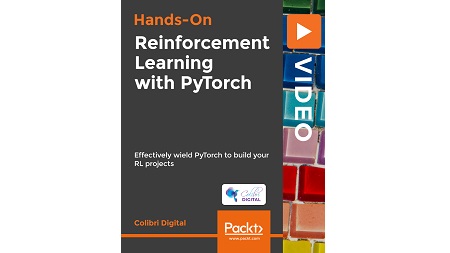
English | MP4 | AVC 1920×1080 | AAC 48KHz 2ch | 3h 06m | 599 MB
Dive into advanced deep reinforcement learning algorithms using PyTorch 1.x
PyTorch, Facebook’s deep learning framework, is clear, easy to code and easy to debug, thus providing a straightforward and simple experience for developers.
This course is your hands-on guide to the core concepts of deep reinforcement learning and its implementation in PyTorch. We will help you get your PyTorch environment ready before moving on to the core concepts that encompass deep reinforcement learning.
Following a practical approach, you will build reinforcement learning algorithms and develop/train agents in simulated OpenAI Gym environments. You’ll learn the skills you need to implement deep reinforcement learning concepts so you can get started building smart systems that learn from their own experiences.
By the end of this course, you will have enhanced your knowledge of deep reinforcement learning algorithms and will be confident enough to effectively use PyTorch to build your RL projects.
Learn
- Build key algorithms using PyTorch
- Implement self-learning agents using PyTorch
- Combine and modify Deep Q Networks and policy gradients to form more powerful algorithms
- Create actor-critic and deep deterministic policy gradients, and apply proximal policy
- Optimization in PyTorch and its extensions to improve performance
- Explore the importance of Q learning, sample efficiency, and the on/off policy in deep reinforcement learning
- Use function approximators, trust regions, and advanced value functions to build upon RL methods and drive new results
- Relate the basics of RL to original Deep RL algorithms, more advanced extensions, and cutting-edge research
Table of Contents
First Steps in Pytorch Reinforcement Learning
1 The Course Overview
2 Setup and Installation of PyTorch
3 PyTorch with GPU in the Cloud
4 Introduction to PyTorch
5 Getting Familiar with Agents, Environments, Rewards, States, and Actions
6 Understanding OpenAI Gym environments
Exploring the Markov Decision Process with Dynamic Programming
7 Using the MDP Framework with Policy Evaluation
8 Using the MDP Framework with Policy Evaluation
9 Improving an Agent with Policy Iteration in Taxi
10 Playing Taxi with Value Iteration
11 Balancing Prediction versus Control and Explore versus Exploit
12 Utilizing Value Functions and Function Approximators
13 Implementing and Training an Agent with Cross-Entropy Method
Dive into Temporal Difference Methods with Deep Q Networks
14 Exploring TD Methods
15 Visualizing the Outcome of SARSA & SARSE
16 Utilizing Q-learning in Deep Q Networks with Pong using PyTorch
17 Implementing a Deep Q Network with PyTorch
18 Code Walkthrough DQN
19 Adding Enhancements with Double DQN
20 Modifying the DQN Architecture with Dueling DQN
Digging Deeper with Monte Carlo and Policy Gradient Methods
21 Using Monte Carlo Methods
22 On-Policy and Off-Policy with Importance Sampling
23 Utilizing Policy Gradient Methods with REINFORCE
24 Implementing Policy Gradients on LunarLander with PyTorch
25 Unifying Monte Carlo and TD Methods
26 Combining Value Functions and Policy Gradients with Actor-Critic
27 Playing Continuous LunarLander with Actor-Critic in Pytorch
28 Applying Actor-Critic in Advanced Architectures
Going Further with Deep Deterministic Policy Gradients
29 Performing Deep Deterministic Policy Gradients
30 Code Walkthrough DDPG
31 Improving DDPG with Variants
32 Working with Deep Reinforcement Learning
Resolve the captcha to access the links!